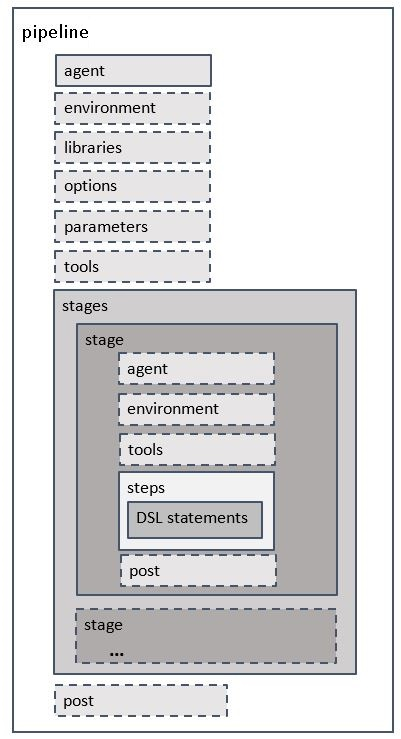Difference between revisions of "Continuous Integration: Releases Jenkins Pipelines"
Manuele.simi (Talk | contribs) (→What is a Jenkinsfile?) |
Manuele.simi (Talk | contribs) (→Pipelines as code: the Jenkinsfile) |
||
| (4 intermediate revisions by the same user not shown) | |||
| Line 33: | Line 33: | ||
* It can integrate with several other plugins | * It can integrate with several other plugins | ||
| − | = | + | = Pipeline as code: the Jenkinsfile = |
A Jenkinsfile is a text file that stores the entire workflow as code and it can be checked into a SCM on your local system. How is this advantageous? This enables the developers to access, edit and check the code at all times. | A Jenkinsfile is a text file that stores the entire workflow as code and it can be checked into a SCM on your local system. How is this advantageous? This enables the developers to access, edit and check the code at all times. | ||
| Line 47: | Line 47: | ||
[[File:Jenkins_pipeline_structure.png|300px]] | [[File:Jenkins_pipeline_structure.png|300px]] | ||
| + | |||
| + | = Reference Documentation = | ||
| + | |||
| + | [https://jenkins.io/solutions/pipeline/ Pipeline as code with Jenkins] | ||
| + | |||
| + | [https://jenkins.io/doc/book/pipeline/syntax Pipeline Syntax] | ||
''Back to the [[Continuous_Integration_procedure_(2019) | CI guide]].'' | ''Back to the [[Continuous_Integration_procedure_(2019) | CI guide]].'' | ||
[[Category:Continuous_Integration]] | [[Category:Continuous_Integration]] | ||
Latest revision as of 23:29, 28 December 2019
Jenkins Pipeline is a combination of plugins that support the integration and implementation of continuous delivery pipelines using Jenkins. A pipeline has an extensible automation server for creating simple or complex delivery pipelines "as code," via pipeline DSL (Domain-specific Language).
Contents
Continuous Delivery and Jenkins
Jenkins has proven to be an expert in implementing continuous integration, continuous testing and continuous deployment to produce good quality software. When it comes to continuous delivery, Jenkins uses a feature called Jenkins pipeline. In order to understand why Jenkins pipeline was introduced, we have to understand what continuous delivery is and why it is important.
In simple words, continuous delivery is the capability to release a software at all times. It is a practice which ensures that the software is always in a production-ready state.
Jenkins Pipelines
What is a Jenkins pipeline?
A pipeline is a collection of jobs that brings the software from version control into the hands of the end users by using automation tools. It is a feature used to incorporate continuous delivery in our software development workflow.
Over the years, there have been multiple Jenkins pipeline releases including, Jenkins Build flow, Jenkins Build Pipeline plugin, Jenkins Workflow, etc. What are the key features of these plugins?
- They represent multiple Jenkins jobs as one whole workflow in the form of a pipeline.
- What do these pipelines do? These pipelines are a collection of Jenkins jobs which trigger each other in a specified sequence.
The maintenance cost for such a complex pipeline is huge and increases with the number of processes. It also becomes tedious to build and manage such a vast number of jobs. To overcome this issue, a new feature called Jenkins Pipeline Project was introduced.
The key feature of this pipeline is to define the entire deployment flow through code. What does this mean? It means that all the standard jobs defined by Jenkins are manually written as one whole script and they can be stored in a version control system. It basically follows the pipeline as code discipline. Instead of building several jobs for each phase, you can now code the entire workflow and put it in a Jenkinsfile. Below is a list of reasons why you should use the Jenkins Pipeline.
Jenkins Pipeline Advantages
- It models simple to complex pipelines as code by using Groovy DSL (Domain Specific Language)
- The code is stored in a text file called the Jenkinsfile which can be checked into a SCM (Source Code Management)
- Improves user interface by incorporating user input within the pipeline
- It is durable in terms of unplanned restart of the Jenkins master
- It can restart from saved checkpoints
- It supports complex pipelines by incorporating conditional loops, fork or join operations and allowing tasks to be performed in parallel
- It can integrate with several other plugins
Pipeline as code: the Jenkinsfile
A Jenkinsfile is a text file that stores the entire workflow as code and it can be checked into a SCM on your local system. How is this advantageous? This enables the developers to access, edit and check the code at all times.
The Jenkinsfile is written using the Groovy DSL and it can be created through a text/groovy editor or through the configuration page on the Jenkins instance. It is written based on two syntaxes, namely:
- Declarative pipeline syntax
- Scripted pipeline syntax
Declarative pipeline is a relatively new feature that supports the pipeline as code concept. It makes the pipeline code easier to read and write. This code is written in a Jenkinsfile which can be checked into a source control management system such as Git. gCube uses declarative pipelines to control the Continuous Delivery process.
The jenkinsfile defines a Declarative Pipeline with the Groovy DSL. This is the typical structure of a declarative pipeline:
Reference Documentation
Back to the CI guide.
